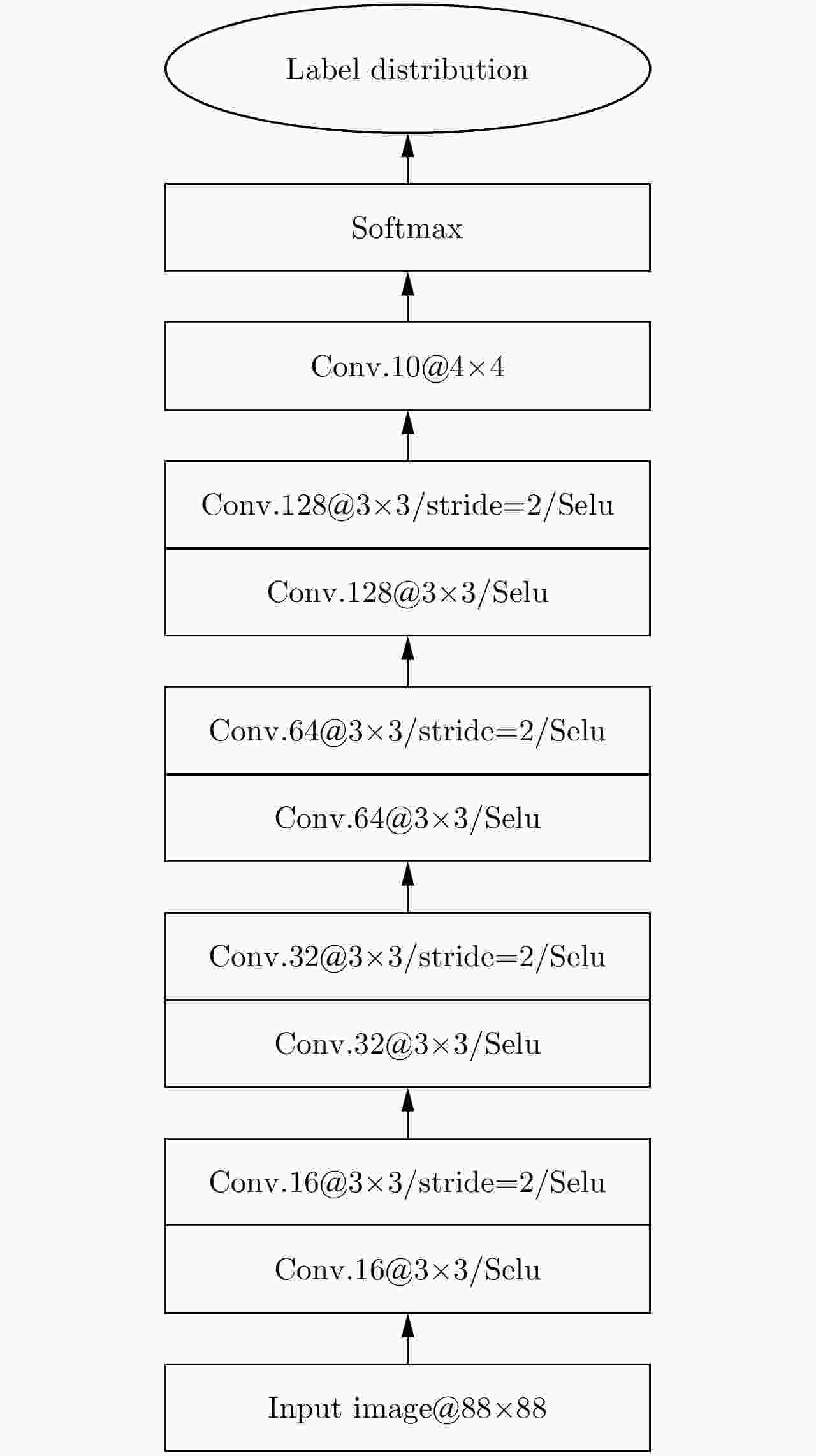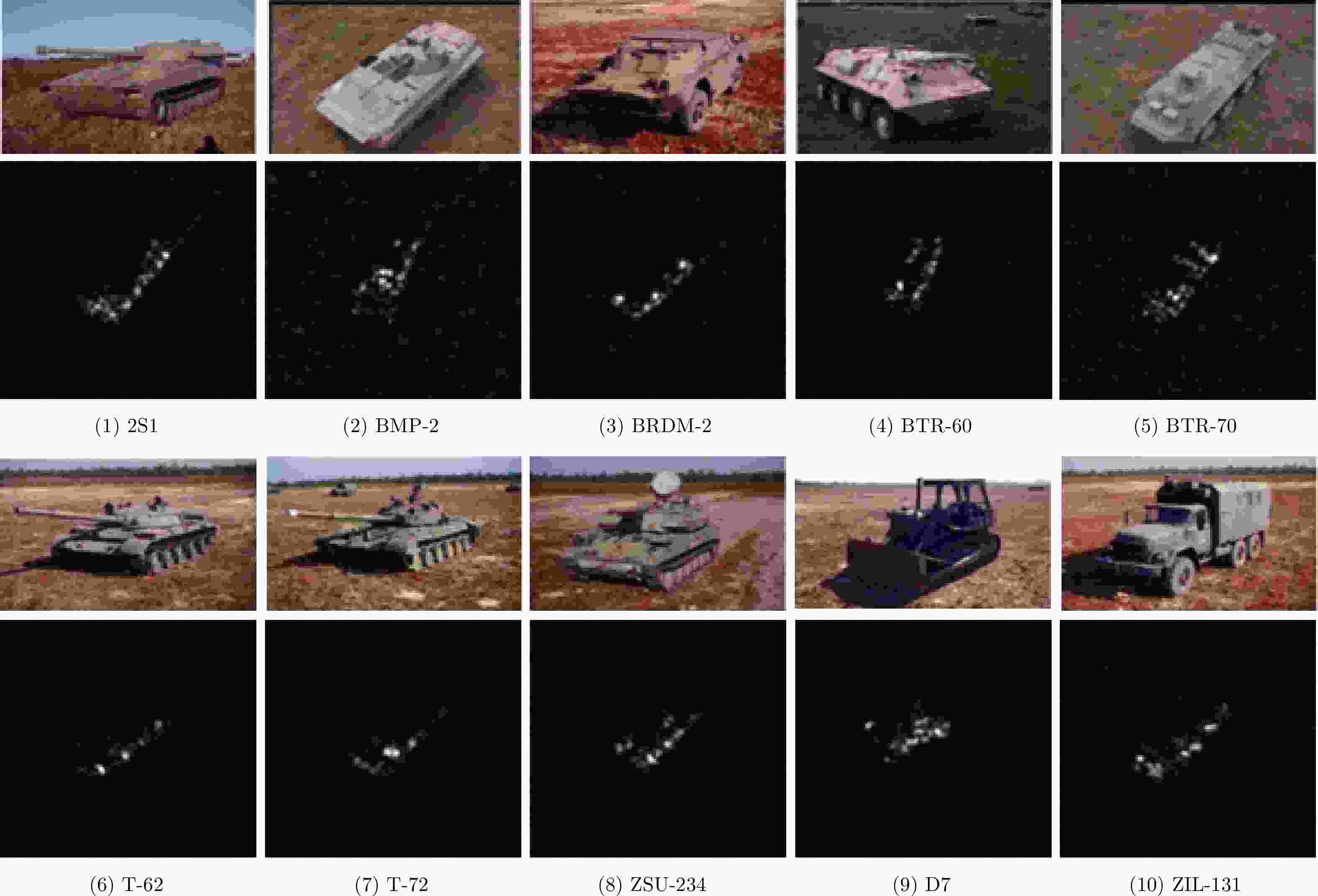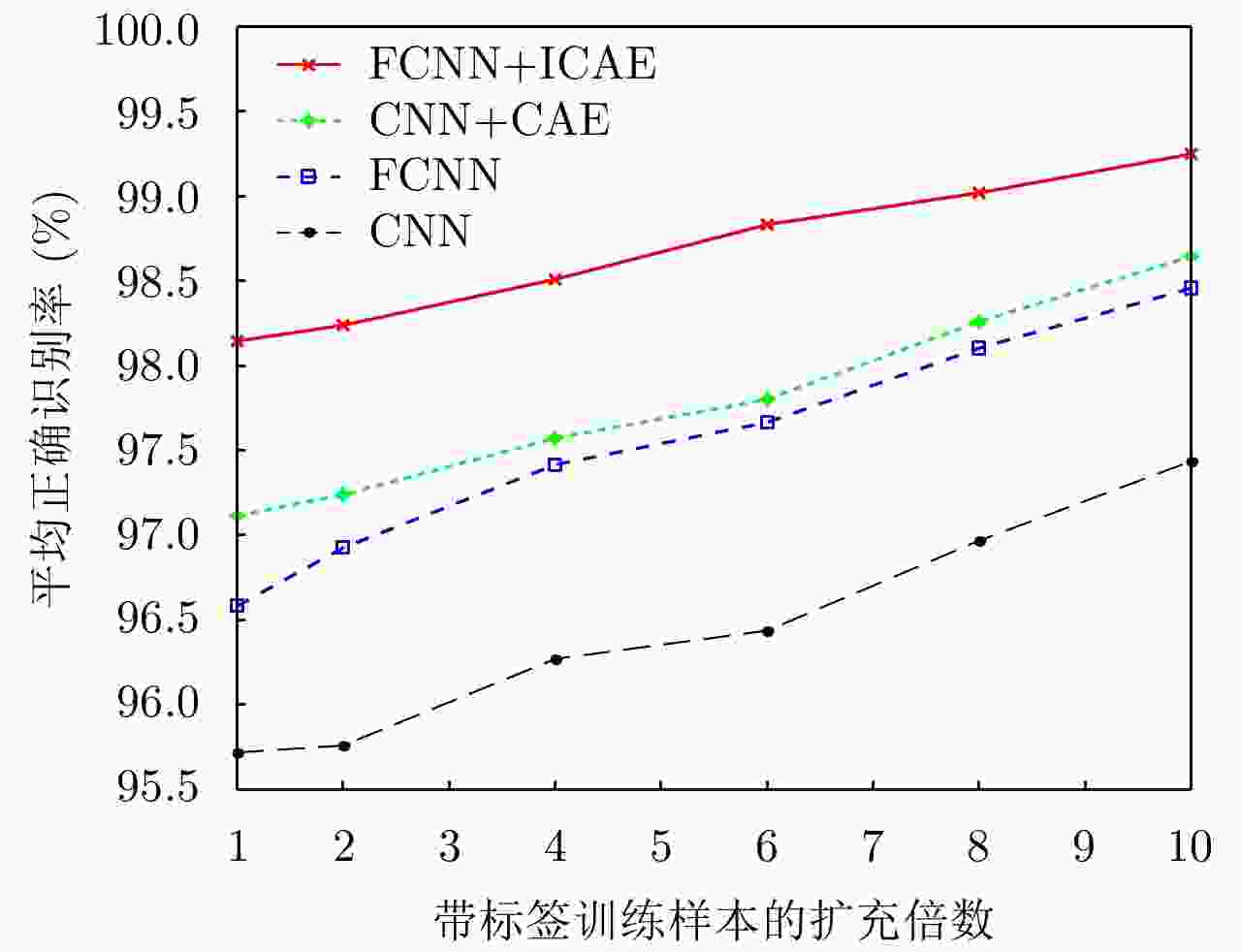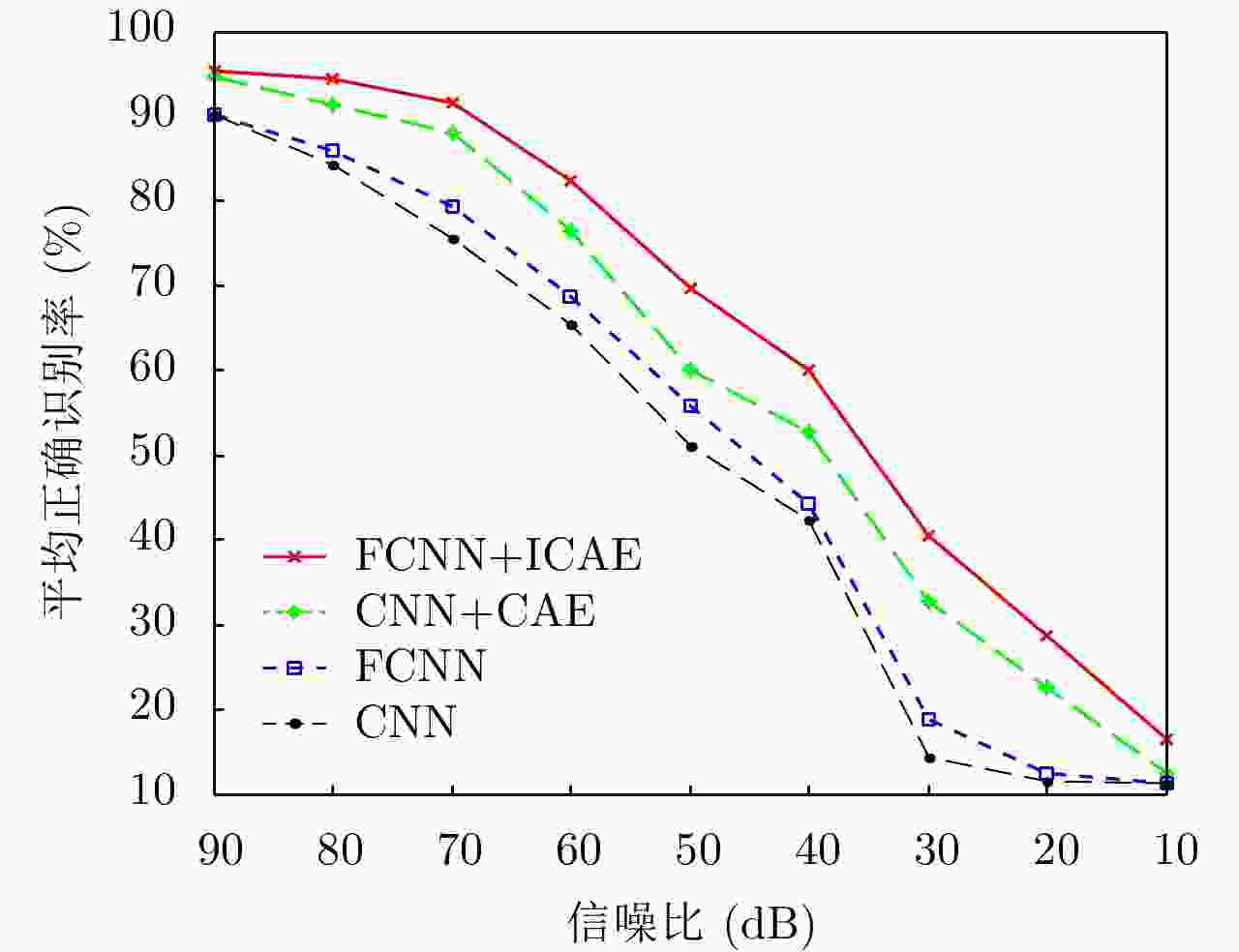SAR ATR Based on FCNN and ICAE
-
摘要: 近年来,基于卷积神经网络(Convolutional Neural Network, CNN)的合成孔径雷达(Synthetic Aperture Radar, SAR)图像目标识别得到深入研究。全卷积神经网络(Fully Convolutional Neural Network, FCNN)是CNN结构上的改进,它比CNN能获得更高的识别率,但在训练过程中仍需要大量的带标签训练样本。该文提出一种基于FCNN和改进的卷积自编码器(Improved Convolutional Auto-Encoder, ICAE)的SAR图像目标识别方法,即先用ICAE无监督训练方式获得的编码器网络参数初始化FCNN的部分参数,后用带标签训练样本对FCNN进行训练。基于MSTAR数据集的十类目标分类实验结果表明,在不扩充带标签训练样本的情况下,该方法不仅能获得98.14%的平均正确识别率,而且具有较强的抗噪声能力。Abstract: In recent years, Synthetic Aperture Radar (SAR) image target recognition based on the Convolutional Neural Network (CNN) has attracted a significant amount of attention. Fully CNN (FCNN) is a structural improvement of the CNN, which features a higher recognition rate than CNN, but it still requires a large number of labeled data in the training process. This study aims to propose a method of SAR image target recognition based on FCNN and Improved Convolutional Auto-Encoder (ICAE), where several parameters of FCNN are initialized by the parameters of the ICAE encoder. These parameters are obtained in the unsupervised training mode. Then, the FCNN is trained by the labeled training samples. The experimental results on 10 kinds of target classification based on the MSTAR datasets show that this method cannot only achieve an average of 98.14% correct recognition rate but also feature a strong anti-noise capability when the labeled training samples are unexpanded.
-
表 1 训练样本和测试样本数量
Table 1. The number of training and testing images
型号 训练集 测试集 角度 数量 角度 数量 BMP-2 17° 233 15° 195 BTR-70 17° 233 15° 196 BTR-60 17° 256 15° 195 BRDM-2 17° 298 15° 274 T-72 17° 232 15° 196 T-62 17° 299 15° 273 2S1 17° 299 15° 274 D7 17° 299 15° 274 ZIL-131 17° 299 15° 274 ZSU-234 17° 299 15° 274 表 2 FCNN, ICAE, CNN和CAE的网络结构
Table 2. The network structures of FCNN, ICAE, CNN and CAE
FCNN ICAE CNN CAE Conv.16@3×3
Conv.16@3×3/stride=2Conv.16@3×3
Conv.16@3×3/stride=2Conv.16@3×3
Maxpooling@2×2Conv.16@3×3
Maxpooling@2×2Conv.32@3×3
Conv.32@3×3/stride=2Conv.32@3×3
Conv.32@3×3/stride=2Conv.32@3×3
Maxpooling@2×2Conv.32@3×3
Maxpooling@2×2Conv.64@3×3
Conv.64@3×3/stride=2Conv.64@3×3
Conv.64@3×3/stride=2Conv.64@3×3
Maxpooling@2×2Conv.64@3×3
Maxpooling@2×2Conv.128@3×3
Conv.128@3×3/stride=2Conv.128@3×3
Conv.128@3×3/stride=2Conv.128@3×3
Maxpooling@2×2Conv.128@3×3
Maxpooling@2×2Conv.10@4×4
SoftmaxUnpooling@2×2
Deconv.64@3×3Conv.10@4×4
SoftmaxUnpooling@2×2
Deconv.64@3×3Unpooling@2×2
Deconv.32@3×3Unpooling@2×2
Deconv.32@3×3Unpooling@2×2
Deconv.16@3×3Unpooling@2×2
Deconv.16@3×3Deconv.1@3×3 Deconv.1@3×3 表 3 基于FCNN和ICAE的识别结果
Table 3. The recognition results based on FCNN and ICAE
目标型号 识别结果 正确识别率
(%)2S1 BMP-2 BRDM-2 BTR-60 BTR-70 D7 T-62 T-72 ZIL-131 ZSU-234 2S1 265 0 1 0 2 0 0 6 0 0 96.72 BMP-2 1 191 0 0 1 1 0 1 0 0 98.45 BRDM-2 0 0 270 3 0 0 0 0 1 0 98.54 BTR-60 0 0 2 186 0 0 1 0 2 4 95.38 BTR-70 3 0 0 0 193 0 0 0 0 0 98.47 D7 0 0 2 0 0 272 0 0 0 0 99.27 T-62 0 0 0 0 0 0 270 0 0 3 98.90 T-72 0 1 0 0 1 0 0 194 0 0 98.98 ZIL-131 0 0 0 0 0 1 2 0 270 1 98.54 ZSU-234 0 0 0 0 0 3 1 1 0 269 98.18 平均正确识别率(%) 98.14 表 4 基于不同方法的实验结果对比
Table 4. The comparison of experimental results based on different methods
目标型号 识别率(%) FCNN+ICAE CNN+CAE FCNN CNN 2S1 96.72 95.99 94.16 96.72 BMP-2 97.95 97.44 96.41 94.36 BRDM-2 98.54 95.99 96.35 95.26 BTR-60 95.38 91.79 95.38 96.41 BTR-70 98.47 99.49 98.98 93.88 D7 99.27 96.35 98.54 97.81 T-62 98.90 97.07 90.84 93.41 T-72 98.98 98.98 98.47 97.96 ZIL-131 98.54 98.91 97.81 96.35 ZSU-234 98.18 98.91 99.64 94.89 平均正确识别率(%) 98.14 97.11 96.58 95.71 -
[1] Wagner S A. SAR ATR by a combination of convolutional neural network and support vector machines[J]. IEEE Transactions on Aerospace and Electronic Systems, 2016, 52(6): 2861–2872. DOI: 10.1109/TAES.2016.160061 [2] Chen S Z, Wang H P, Xu F, et al. Target classification using the deep convolutional networks for SAR images[J]. IEEE Transactions on Geoscience and Remote Sensing, 2016, 54(8): 4806–4817. DOI: 10.1109/TGRS.2016.2551720 [3] Zhang Z M, Wang H P, Xu F, et al. Complex-valued convolutional neural network and its application in polarimetric SAR image classification[J]. IEEE Transactions on Geoscience and Remote Sensing, 2017, 55(12): 7177–7188. DOI: 10.1109/TGRS.2017.2743222 [4] Furukawa H. Deep learning for target classification from SAR imagery: Data augmentation and translation invariance[J]. IEICE Technical Report, 2017, 117(182): 13–17. [5] 徐丰, 王海鹏, 金亚秋. 深度学习在SAR目标识别与地物分类中的应用[J]. 雷达学报, 2017, 6(2): 136–148. DOI: 10.12000/JR16130Xu Feng, Wang Haipeng, and Jin Yaqiu. Deep learning as applied in SAR target recognition and terrain classification[J]. Journal of Radars, 2017, 6(2): 136–148. DOI: 10.12000/JR16130 [6] Morgan D A E. Deep convolutional neural networks for ATR from SAR imagery[C]. Proceedings of SPIE 9475, Algorithms for Synthetic Aperture Radar Imagery XXII, Baltimore, Maryland, United States, 2015: 94750F. [7] Profeta A, Rodriguez A, and Clouse H S. Convolutional neural networks for synthetic aperture radar classification[C]. Proceedings of SPIE 9843, Algorithms for Synthetic Aperture Radar Imagery XXIII, Baltimore, Maryland, United States, 2016: 98430M. [8] Wilmanski M, Kreucher C, and Lauer J. Modern approaches in deep learning for SAR ATR[C]. Proceedings of SPIE 9843, Algorithms for Synthetic Aperture Radar Imagery XXIII, Baltimore, Maryland, United States, 2016: 98430N. [9] Wagner S. Combination of convolutional feature extraction and support vector machines for radar ATR[C]. Proceedings of the 17th International Conference on Information Fusion, Salamanca, Spain, 2014: 1–6. [10] Pei J F, Huang Y L, Huo W B, et al. SAR automatic target recognition based on multiview deep learning framework[J]. IEEE Transactions on Geoscience and Remote Sensing, 2018, 56(4): 2196–2210. DOI: 10.1109/TGRS.2017.2776357 [11] Lin Z, Ji K F, Kang M, et al. Deep convolutional highway unit network for SAR target classification with limited labeled training data[J]. IEEE Geoscience and Remote Sensing Letters, 2017, 14(7): 1091–1095. DOI: 10.1109/LGRS.2017.2698213 [12] Chen S Z and Wang H P. SAR target recognition based on deep learning[C]. Proceedings of 2014 International Conference on Data Science and Advanced Analytics, Shanghai, China, 2015: 541–547. [13] El Housseini A, Toumi A, and Khenchaf A. Deep learning for target recognition from SAR images[C]. Proceedings of 2017 Seminar on Detection Systems Architectures and Technologies, Algiers, Algeria, 2017: 1–5. [14] 田壮壮, 占荣辉, 胡杰民, 等. 基于卷积神经网络的SAR图像目标识别研究[J]. 雷达学报, 2016, 5(3): 320–325. DOI: 10.12000/JR16037Tian Zhuangzhuang, Zhan Ronghui, Hu Jiemin, et al. SAR ATR based on convolutional neural network[J]. Journal of Radars, 2016, 5(3): 320–325. DOI: 10.12000/JR16037 [15] Springenberg J T, Dosovitskiy A, Brox T, et al.. Striving for simplicity: The all convolutional net[OL]. arXiv preprint arXiv:1412.6806, 2015. [16] Hinton G E and Salakhutdinov R R. Reducing the dimensionality of data with neural networks[J]. Science, 2006, 313(5786): 504–507. DOI: 10.1126/science.1127647 [17] 康妙, 计科峰, 冷祥光, 等. 基于栈式自编码器特征融合的SAR图像车辆目标识别[J]. 雷达学报, 2017, 6(2): 167–176. DOI: 10.12000/JR16112Kang Miao, Ji Kefeng, Leng Xiangguang, et al. SAR target recognition with feature fusion based on stacked autoencoder[J]. Journal of Radars, 2017, 6(2): 167–176. DOI: 10.12000/JR16112 [18] 赵飞翔, 刘永祥, 霍凯. 基于栈式降噪稀疏自动编码器的雷达目标识别方法[J]. 雷达学报, 2017, 6(2): 149–156. DOI: 10.12000/JR16151Zhao Feixiang, Liu Yongxiang, and Huo Kai. Radar target recognition based on stacked denoising sparse autoencoder[J]. Journal of Radars, 2017, 6(2): 149–156. DOI: 10.12000/JR16151 [19] Masci J, Meier U, Cireşan D, et al.. Stacked convolutional auto-encoders for hierarchical feature extraction[C]. Proceedings of the 21st International Conference on Artificial Neural Networks on Artificial Neural Networks and Machine Learning – ICANN 2011, Espoo, Finland, 2011: 52–59. [20] Vincent P, Larochelle H, Bengio Y, et al.. Extracting and composing robust features with denoising autoencoders[C]. Proceedings of the 25th International Conference on Machine Learning, Helsinki, Finland, 2008: 1096–1103. [21] Rumelhart D E, Hinton G E, and Williams R J. Learning representations by back-propagating errors[J]. Nature, 1986, 323(6088): 533–536. DOI: 10.1038/323533a0 [22] Klambauer G, Unterthiner T, Mayr A, et al.. Self-normalizing neural networks[C]. Proceedings of the 31st Neural Information Processing Systems, Long Beach, CA, United States, 2017: 972–981. [23] Kingma D P and Ba J L. Adam: A method for stochastic optimization[OL]. arXiv preprint arXiv:1412.6980, 2015. [24] Dong G G, Wang N, and Kuang G Y. Sparse representation of monogenic signal: With application to target recognition in SAR images[J]. IEEE Signal Processing Letters, 2014, 21(8): 952–956. DOI: 10.1109/LSP.2014.2321565 -



 作者中心
作者中心 专家审稿
专家审稿 责编办公
责编办公 编辑办公
编辑办公

 下载:
下载:











